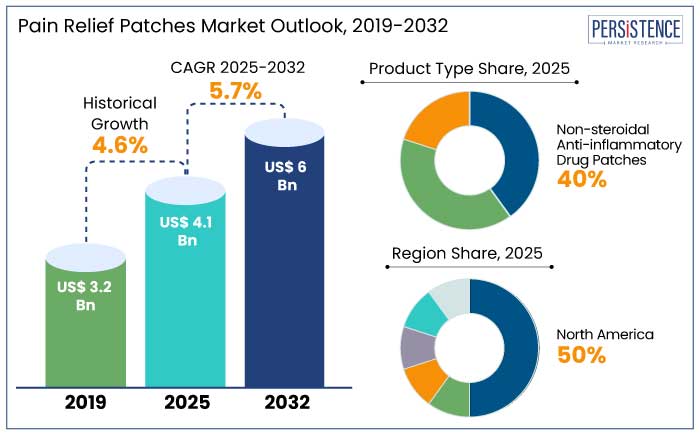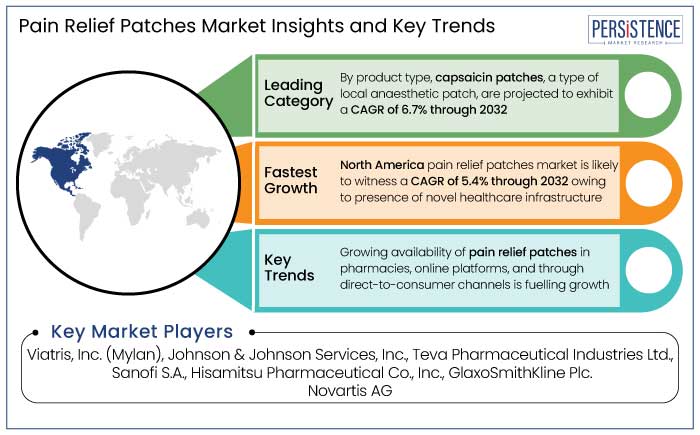ID: PMRREP33349| 250 Pages | 28 Jan 2025 | Format: PDF, Excel, PPT* | Healthcare

The global pain relief patches market is predicted to reach a size of US$ 4.1 Bn by 2025. It is anticipated to showcase a CAGR of 5.7% during the forecast period to attain a value of US$ 6 Bn by 2032.
Chronic pain, especially musculoskeletal and neuropathic pain, is becoming prevalent owing to the aging population, sedentary lifestyles, and rising rates of obesity. This trend is predicted to drive the demand for effective pain relief solutions like pain relief patches.
Pain relief patches provide a non-addictive, localized, and effective solution for managing both acute and chronic pain. The opioid crisis, especially in the U.S. has led to a significant decline in the prescription of opioid painkillers. Consumers and healthcare providers are turning to alternative pain relief methods, like non-opioid topical treatments.

Key Highlights of the Industry
|
Market Attributes |
Key Insights |
|
Pain Relief Patches Market Size (2025E) |
US$ 4.1 Bn |
|
Projected Market Value (2032F) |
US$ 6 Bn |
|
Global Market Growth Rate (CAGR 2025 to 2032) |
5.7% |
|
Historical Market Growth Rate (CAGR 2019 to 2023) |
4.6% |
North America pain relief patches market is estimated to hold a share of 50% in 2025. Opioid crisis in North America, especially in the U.S., has led to a significant push for non-opioid alternatives for pain management. Pain relief patches, which provide localized relief without the risks of addiction or side effects associated with oral opioids, have gained significant traction.
Consumers in the region are becoming increasingly aware regarding the benefits of topical pain relief treatments. Growing awareness of pain management options, including patches that deliver active ingredients directly to the source of pain, is driving demand.
Non-steroidal anti-inflammatory drug (NSAID) patches are anticipated to hold a share of 40% in 2025. NSAID patches are increasingly preferred by consumers and healthcare professionals for managing conditions like arthritis, musculoskeletal pain, and post-surgical pain. This popularity is attributed to their ability to provide targeted relief for pain at the site of application, delivering the active ingredients directly to the pain source.
NSAID patches are a non-invasive and easy-to-use alternative to oral medications and other forms of pain relief like injections or physical therapies. This convenience is driving their popularity, especially in the self-care segment.
Menstrual cramps are anticipated to hold a share of 29% in 2025. Studies indicate that a large proportion of women suffer from menstrual pain, making it a key driver for the pain relief patches market.
Several women prefer non-invasive, over-the-counter (OTC) solutions for managing menstrual cramps. Pain relief patches, especially those that deliver heat or NSAIDs typically, offer a convenient and discreet alternative to oral medications.
Heat therapy is particularly effective in alleviating menstrual cramps by relaxing the muscles in the abdominal area, while NSAID patches provide anti-inflammatory benefits. Recent advancements in the formulation and design of pain relief patches have made them more effective and comfortable for users. Some patches for menstrual cramps combine heat therapy with natural ingredients, providing additional soothing effects, leading to increased adoption.
Potential growth in the global pain relief patches industry is predicted to be driven by technological advancements, including smart patches capable of monitoring pain levels and delivering real-time relief. Increasing focus on non-invasive solutions for menstrual pain is predicted to continue driving growth. Integration of telehealth and wearable technology with pain relief patches like apps that track pain levels and adjust the medication dosage are likely to contribute to evolution.

The pain relief patches market growth was decent at a CAGR of 4.6% during the historical period. The period witnessed a demand for topical pain relief solutions owing to increasing awareness regarding alternatives for oral medications and concerns over the side effects of conventional painkillers.
During the COVID-19 pandemic, people increasingly turned to at-home treatment options for managing chronic pain due to restrictions on visits to healthcare facilities, thereby fostering growth in the market.
Adoption of non-steroidal anti-inflammatory drug (NSAID) patches and menthol-based patches continued to rise. This growth was attributed to their efficacy in providing targeted relief without the need for oral medications.
The forecast period is estimated to witness advanced pain relief patches with sustained-release mechanisms, combination therapies, and herbal/organic formulations. This results in effective and comfortable solutions for consumers. Rise of health-conscious lifestyles along with increased focus on holistic well-being are promoting the use of natural and safe remedies like topical patches.
Convenience and Ease of Use
Pain relief patches are typically designed to be applied directly to the affected area, requiring minimal effort from users. They are self-adhesive, enabling consumers to easily place them on the skin and wear them throughout the day or night. This simplicity makes them particularly attractive to individuals looking for a quick and hassle-free solution to manage pain without requiring special skills or professional help.
Several pain relief patches are thin and clear, making them invisible when worn under clothing. This is ideal for individuals who want to manage their pain without drawing attention to the product they are using. This discreet nature adds to their appeal, particularly for those seeking solutions that won't interfere with their daily lives.
Pain relief patches often provide sustained and continuous pain relief over an extended period depending on the product. The slow-release mechanism of active ingredients ensures that users experience relief without needing to reapply frequently or take oral medications multiple times a day.
Increasing Awareness and Acceptance of Self-care
The healthcare industry is witnessing a shift as consumers are taking more responsibility for their own health. People are more informed and proactive about managing their wellness, resulting in a greater focus on self-care, including pain management. Increased acceptance of home-based treatments has encouraged people to seek solutions like pain relief patches.
Rise in self-care is supported by various educational campaigns from manufacturers and healthcare professionals. These campaigns highlight the benefits of pain relief patches, focusing on their ease of use, effectiveness, and ability to deliver localized relief without the need for oral medication.
Environmental Impact of Disposable Patches
Pain relief patches, particularly those that are disposable, contribute to significant waste generation. Increasing consumption of single-use patches, along with the plastic materials used in their production, exacerbates this issue.
Several pain relief patches contain plastic-based materials in their adhesive backing, as well as active pharmaceutical ingredients embedded in polymers. These materials are not biodegradable, and their improper disposal could lead to long-term environmental degradation.
Shift toward Non-invasive Treatments
As consumers become aware of the risks and complications associated with invasive treatments, there is a growing preference for non-invasive pain management solutions like topical patches. Non-invasive treatments are perceived to be safer, convenient, and easy to use.
Pain relief patches offer the convenience of home use, enabling consumers to manage their pain without needing to visit healthcare facilities. Patches can be applied easily and discreetly, providing targeted relief without the need for special equipment or healthcare providers.
Preference for Over-the-counter (OTC) Solutions
OTC pain relief patches are easily available at pharmacies, supermarkets, and even online platforms, making them highly accessible to consumers. This ease of access has contributed to the widespread adoption of pain relief patches.
OTC pain relief patches are a cost-effective option for individuals seeking pain relief without incurring high medical expenses. As more people embrace self-care practices, OTC products like pain relief patches are becoming increasingly popular.
Companies in the pain relief patches market are investing in research and development to improve the effectiveness, comfort, and duration of pain relief patches. This includes the development of advanced formulation that provide long lasting relief, enhanced adhesion, and better skin compatibility.
A few manufacturers are incorporating non-steroidal anti-inflammatory drugs (NSAIDs) in their patches to target specific pain relief. They are also adding herbal or natural ingredients to appeal to consumers looking for alternative treatments.
Businesses are focusing on expanding in emerging markets as they are witnessing a rise in healthcare access. They are also progressively partnering with healthcare providers, distributors, and ecommerce platforms to expand their reach.
|
The market is anticipated to reach a value of US$ 6 Bn by 2032.
Non-steroidal anti-inflammatory drug patches are predicted to hold a share of 40% in 2025.
North America is anticipated to emerge as the leading region with a share of 50% in 2025.
Prominent players in the market include Viatris, Inc. (Mylan), Johnson & Johnson Services, Inc., and Teva Pharmaceutical Industries Ltd.
The market is predicted to witness a CAGR of 5.7% throughout the forecast period.
|
Attributes |
Detail |
|
Forecast Period |
2025 to 2032 |
|
Historical Data Available for |
2019 to 2023 |
|
Market Analysis |
US$ Billion for Value |
|
Key Regions Covered |
|
|
Key Market Segments Covered |
|
|
Key Companies Profiled in the Report |
|
|
Report Coverage |
|
|
Customization and Pricing |
Available upon request |
By Product Type
By Indication
By Distribution Channel
By Region
Delivery Timelines
For more information on this report and its delivery timelines please get in touch with our sales team.
About Author